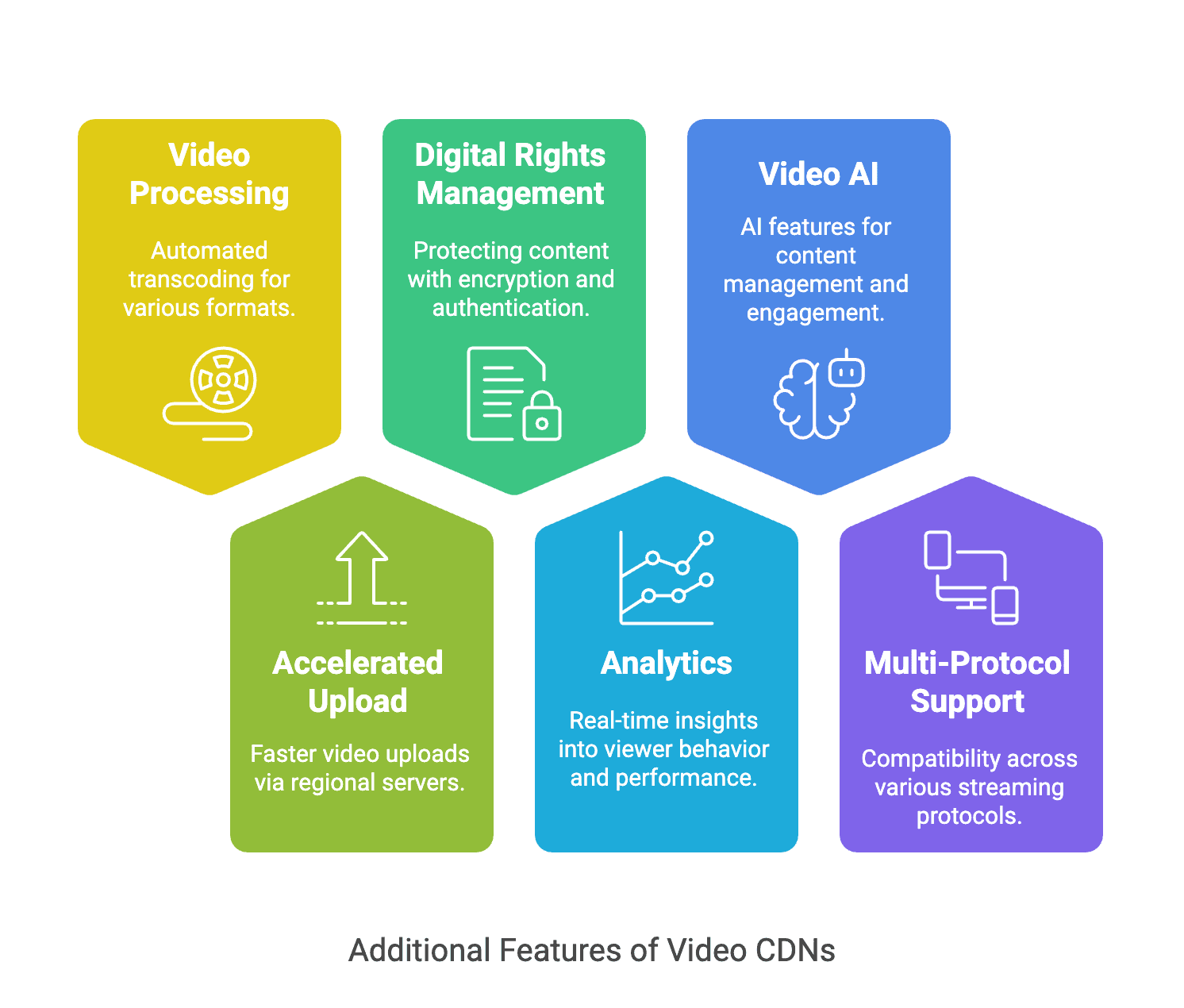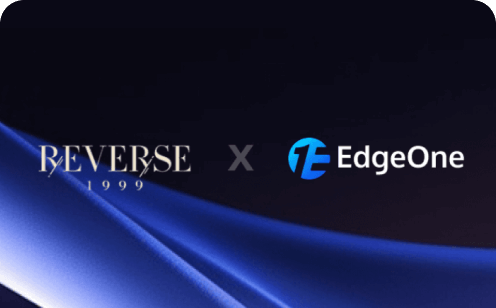Best CDN for Video Streaming: Understanding Video CDNs and Top 5 Providers (2025)
Video streaming traffic now accounts for over 80% of all internet traffic, with billions of hours of content consumed daily across entertainment, education, and business platforms. As streaming demands intensify, content providers face increasing pressure to deliver high-quality video experiences to global audiences. This comprehensive guide explores how Content Delivery Networks (CDNs) power modern video streaming, examining their crucial role in content delivery and introducing the leading providers shaping the industry's future.
What is Video Streaming?
Video streaming is the continuous transmission of video content over the internet, allowing viewers to watch content in real-time without downloading the entire file. This technology enables users to access video content instantly, whether it's live broadcasts or on-demand content. Modern streaming platforms use advanced protocols to break content into small packets, delivering them sequentially for seamless playback across diverse devices and networks.
The evolution of video streaming traces back to the late 1990s, when pioneering companies like RealNetworks and Microsoft introduced the first streaming technologies. These early solutions struggled with limited bandwidth and poor video quality, often delivering small, pixelated videos. The landscape transformed dramatically with YouTube's launch in 2005, which democratized video sharing, and Netflix's pivot to streaming in 2007, which revolutionized content delivery. These milestones, combined with increasing internet speeds and improved compression technologies, set the foundation for today's streaming ecosystem.

Today, video streaming encompasses multiple formats and delivery methods, from Video-on-Demand (VOD) services like Netflix and Disney+ to live streaming platforms such as Twitch and YouTube Live. The technology has evolved to support 4K resolution, HDR content, and interactive features, while adaptive bitrate streaming ensures optimal viewing experiences across varying network conditions. This continuous innovation has made streaming the dominant method of video consumption, fundamentally changing how we create, distribute, and consume content.
What is a Video CDN?
A Video CDN (Content Delivery Network) is a specialized infrastructure optimized for video distribution at scale. At its core, it consists of a network of interconnected servers strategically placed worldwide, designed to cache and deliver video content from locations closest to end users. These distributed servers work in harmony to handle the unique challenges of video delivery, including managing large file sizes, supporting multiple bitrates, and implementing adaptive streaming technologies to maintain consistent quality across varying network conditions.
Unlike traditional CDNs, video CDNs incorporate specialized features tailored specifically for video content, such as video transcoding, adaptive bitrate streaming, and real-time analytics. These networks employ sophisticated algorithms to determine the optimal server for each viewer based on factors like geographic location, network conditions, and server load. They also provide advanced features such as dynamic packaging to support different streaming protocols (HLS, DASH, etc.), content protection mechanisms, and detailed performance monitoring tools that help content providers deliver professional-grade streaming experiences to their audiences.
The working mechanism of a Video CDN begins when content providers upload their videos to an origin server. The CDN system processes these videos, creating multiple versions at different quality levels and formats to ensure broad device compatibility. These processed videos are then distributed to a network of edge servers worldwide based on the content provider's distribution strategy and regional demand. When a viewer requests a video, the CDN's intelligent routing system analyzes their location and network conditions to determine the optimal edge server for content delivery.
Why are Video CDNs Essential for Streaming?
As the backbone of modern video delivery, Video CDNs serve as the critical infrastructure that powers streaming platforms worldwide, ensuring content reaches viewers quickly and reliably while maintaining optimal quality across different network conditions and geographical locations.
- Global Reach: They enable content providers to deliver videos to viewers worldwide with minimal latency by serving content from nearby servers.
- Scalability: Video CDNs can handle sudden spikes in viewer traffic, making them essential for large-scale broadcasts and popular content.
- Quality of Experience: Through advanced caching and routing technologies, CDNs ensure smooth playback and minimize buffering, even for high-definition content.
- Cost Efficiency: By optimizing delivery routes and reducing origin server load, CDNs help content providers manage bandwidth costs while maintaining high-quality streaming.
- Reliability: The distributed nature of CDNs provides built-in redundancy, ensuring consistent service even if some servers experience issues.
- Security: Modern video CDNs offer comprehensive security features including DDoS protection, content encryption, and access control mechanisms, safeguarding both content and infrastructure from cyber threats.
These combined benefits make video CDNs an essential infrastructure component for any organization delivering video content at scale, from streaming platforms and broadcasters to educational institutions and enterprise communications, where reliable, high-quality video delivery is crucial for success.
Additional Features of Modern Video CDNs

Beyond basic content delivery, modern Video CDNs offer a comprehensive suite of features that enhance video streaming operations. Here are the key additional capabilities that make Video CDNs indispensable for content providers:
1. Video Processing and Transcoding
Video CDNs provide automated transcoding services that convert uploaded content into multiple formats and bitrates. This ensures compatibility across different devices and network conditions, while adaptive bitrate streaming dynamically adjusts quality based on viewer's connection speed, delivering optimal viewing experiences.
2. Accelerated Video Upload
Video CDNs maintain a network of specialized upload servers located in different regions worldwide. When content creators upload videos, the system automatically routes the upload to the nearest storage center, similar to how a package delivery service uses local distribution centers. Combined with advanced file transfer technologies that allow simultaneous chunk uploads and automatic resume after interruptions, this system makes the upload process significantly faster than traditional methods.
3. Digital Rights Management (DRM)
Modern Video CDNs integrate robust DRM solutions to protect valuable content assets. This includes encryption, watermarking, and token-based authentication systems that prevent unauthorized access and content piracy while ensuring seamless playback for legitimate viewers.
4. Analytics and Monitoring
Advanced analytics platforms provide real-time insights into viewer behavior, streaming performance, and content consumption patterns. These tools help content providers optimize delivery, understand audience preferences, and troubleshoot issues proactively.
5. Video AI and Processing
CDNs now offer AI-powered features including automated thumbnail generation, content moderation, and metadata extraction. These capabilities streamline content management workflows and enhance viewer engagement through intelligent content optimization.
6. Multi-Protocol Support
Video CDNs support multiple streaming protocols (HLS, DASH, etc.) and automatically package content in the most suitable format for each viewer's device and platform, ensuring broad compatibility and optimal delivery.
5 Best CDNs for Video Streaming
1. EdgeOne
EdgeOne, developed by Tencent Cloud, represents a cutting-edge global content delivery network that combines traditional CDN capabilities with advanced security features. With over 3,200 edge nodes worldwide and leveraging more than 20 years of network technology experience, EdgeOne has established itself as a powerful player in the CDN market, particularly strong in the Asia-Pacific region.
The platform demonstrates exceptional performance in video delivery and security, backed by Tencent's extensive infrastructure and deep understanding of gaming and video streaming requirements. Its architecture is specifically designed to handle the challenges of modern video delivery while providing comprehensive protection against various cyber threats.
Key Advantages:
- Extensive network coverage in Asia-Pacific
- Advanced security features including DDoS protection
- Real-time resource scheduling
- Integrated security solutions
Video CDN Features:
- Multi-bitrate adaptive streaming
- Real-time video transcoding
- Low-latency live streaming
- Advanced analytics and monitoring
- Intelligent routing algorithms
Pricing: EdgeOne delivers enterprise-grade video delivery capabilities with an accessible pricing structure, featuring a free plan period with 1TB of data transfer. The platform's standard package starts at $0.9 monthly with data transfer rates of $0.018/GB, while new users can access promotional rates reducing the monthly fee to $0.4.
2. Akamai
Akamai stands as one of the world's most established CDN providers, operating the largest global server network spanning over 130 countries. As a pioneer in content delivery technology, Akamai has built its reputation on delivering exceptional performance and reliability for major streaming platforms and broadcasters worldwide.
The company's extensive experience in handling large-scale streaming events and its continuous innovation in video delivery technology make it a preferred choice for enterprise-level streaming operations. Akamai's platform is particularly noted for its ability to handle massive concurrent viewer loads while maintaining consistent quality across diverse geographic locations.
Key Advantages:
- Largest global server network
- Industry-leading reliability
- Extensive streaming experience
- Comprehensive security features
Video CDN Features:
- Advanced media delivery solutions
- Adaptive Media Player
- Cloud-based transcoding
- Media analytics and reporting
- Multi-DRM support
Pricing: Akamai implements a customized pricing model based on traffic volume, geographic distribution, and feature requirements. While specific rates are negotiated directly, enterprise contracts typically include volume discounts and service level agreements.
3. CloudFront
Amazon CloudFront leverages AWS's vast infrastructure to provide a robust, scalable CDN service that integrates seamlessly with other AWS services. The platform excels in providing a unified solution for businesses already utilizing AWS infrastructure, offering comprehensive video delivery capabilities alongside powerful cloud computing features.
CloudFront's architecture is designed to handle both live streaming and video-on-demand content efficiently, with deep integration into AWS's ecosystem providing additional benefits for content processing, storage, and delivery. This integration makes it particularly attractive for businesses looking to build complete video streaming solutions.
Key Advantages:
- Deep AWS service integration
- Global edge location network
- Pay-as-you-go pricing
- Advanced security features
Video CDN Features:
- Integration with AWS Media Services
- Field-level encryption
- Live streaming support
- Real-time metrics
- Lambda@Edge for custom processing
Pricing: CloudFront offers an attractive pricing model that includes 1TB of free data transfer each month as part of the AWS Free Tier, making it an excellent choice for businesses with lower traffic volumes seeking a professional-grade video CDN solution at no cost. Beyond the free tier, CloudFront implements a pay-as-you-go model with rates starting from $0.085 per GB in North America and Europe, with additional savings available through the AWS Savings Bundle program.
4. Cloudflare
Cloudflare has established itself as a leading CDN provider with a strong focus on security and performance optimization. Their network spans over 335 cities globally, offering an integrated platform that combines CDN services with advanced security features and edge computing capabilities.
The platform stands out for its ease of use and automatic optimization features, making it particularly attractive for businesses seeking a balance between performance and security. Cloudflare's continuous innovation in edge computing and security has made it a popular choice for both small businesses and large enterprises.
Key Advantages:
- Strong security and DDoS protection
- User-friendly interface
- Extensive free tier features
- Automatic platform optimization
Video CDN Features:
- Adaptive bitrate streaming
- Stream live video at scale
- Video optimization tools
- Built-in analytics
- Edge computing capabilities
Pricing: Cloudflare provides multiple pricing tiers starting with a free plan, though video hosting is not supported in the free tier. Their Pro plan, priced at $20/month, introduces enhanced performance and security features. For organizations requiring advanced capabilities, Business plans start at $200/month, while Enterprise plans include custom pricing based on specific feature requirements and volume needs.
5. Fastly
Fastly distinguishes itself through its real-time CDN capabilities and powerful edge computing features. The platform is built for modern streaming requirements, offering instant configuration changes and an API-first approach that enables deep customization of content delivery workflows.
Known for serving major platforms like Epic Games, Spotify, and Reddit, Fastly has built its reputation on delivering exceptional performance and customization options. Their architecture is particularly well-suited for organizations requiring granular control over their content delivery and those prioritizing real-time performance.
Key Advantages:
- Real-time configuration changes
- API-first approach
- Advanced edge computing
- High performance network
Video CDN Features:
- Real-time video streaming
- Edge-based video optimization
- Custom video delivery workflows
- Detailed real-time analytics
- Advanced cache control
Pricing: Fastly offers a monthly credit of $50 for CDN traffic to all customers. Their bandwidth-based pricing model starts at $0.12 per GB for North America and Europe regions, with rates varying for other geographic locations and decreasing based on volume. Custom pricing options are available for enterprise customers with high-volume requirements.
How to Choose the Right Video CDN Provider?
1. Geographic Coverage and Performance
When selecting a video CDN provider, geographic coverage and network performance are crucial factors that directly affect your users' streaming experience. The provider's presence in your target regions plays a significant role in determining streaming quality, latency, and overall viewer satisfaction. A CDN with strong coverage in your primary markets can greatly reduce buffering and ensure smoother playback.
For global operations, providers like Akamai and Cloudflare offer extensive worldwide coverage, while EdgeOne has particular strengths in the Asia-Pacific region. It's advisable to conduct performance tests in your key markets and analyze each provider's point of presence (PoP) distribution to guarantee optimal coverage for your audience.
2. Cost Structure and Business Model
Understanding the cost implications of different CDN providers is essential for long-term sustainability. Each provider has distinct pricing models that can significantly impact your operational costs based on traffic patterns and usage volumes. The choice between pay-as-you-go models, committed use discounts, and tiered pricing structures should align with your business growth projections.
For startups and smaller operations, providers like CloudFront and EdgeOne offer attractive entry points with free tiers and competitive rates. Larger enterprises might see value in Akamai's custom pricing or Fastly's volume-based discounts. It's important to consider not only the base pricing but also any additional costs for features like security, analytics, and advanced streaming capabilities.
3. Scalability and Reliability
A video CDN's ability to scale with your growth while maintaining reliability is crucial for long-term success. The provider should offer a robust infrastructure capable of handling sudden traffic spikes and increasing audience demands without degrading service quality. Evaluate both technical scalability and commercial flexibility in your assessment.
Established providers like Akamai have proven track records with large-scale events, while newer platforms such as EdgeOne showcase innovative approaches to scaling and reliability. Be sure to review each provider's uptime guarantees, redundancy measures, and capacity to manage your peak traffic scenarios.
4. Security and Compliance
The protection of video content and the security of your platform are increasingly important considerations when selecting a CDN. Each provider offers varying levels of security features, from basic DDoS protection to advanced content protection mechanisms. Assess your specific security needs and compliance requirements when evaluating providers.
EdgeOne and Cloudflare prioritize security features in their offerings, while Akamai provides enterprise-grade security solutions. It's essential to evaluate each provider's security capabilities in light of your requirements and industry standards.
Conclusion
Choosing the right video CDN is crucial for delivering high-quality streaming experiences to your audience. While this guide focuses on premium video CDN providers, organizations with different needs might want to explore more cost-effective options. For budget-conscious businesses, check out our guide on "Best Cheap CDN Services in 2025" which covers affordable CDN solutions. If you're primarily dealing with image content, our "Comparison of Free Image CDN Services" provides insights into specialized image delivery networks.
Ready to enhance your video streaming capabilities? Try EdgeOne's free plan with 1TB of data transfer. Experience enterprise-grade performance and advanced security features that power modern video delivery.
FAQs
Q1: What is a Video CDN and why do I need it?
A1: A Video CDN is a specialized content delivery network that optimizes video streaming delivery through distributed servers, ensuring smooth playback and reducing buffering for your viewers worldwide.
Q2: How do I choose the best Video CDN for my needs?
A2: Consider factors like geographic coverage, pricing structure, technical requirements, and your target audience location - select a provider that offers strong presence in your primary markets with features matching your specific needs.
Q3: What's the difference between live streaming and VOD CDN services?
A3: Live streaming CDN services focus on real-time content delivery with minimal latency, while VOD (Video on Demand) CDN services optimize for reliable playback of stored content with efficient caching mechanisms.
Q4: Do I need different CDNs for different regions?
A4: While a single global CDN provider can often meet your needs, some organizations use multi-CDN strategies to optimize performance in specific regions, especially when targeting audiences in areas like China.
Q5: How does CDN pricing work for video streaming?
A5: Most video CDN providers charge based on bandwidth usage (per GB transferred), with some offering additional features like free tiers, volume discounts, and included storage capacity.
Q6: What security features should I look for in a Video CDN?
A6: Essential security features include DRM support, token authentication, SSL encryption, and geographic restrictions to protect your content from unauthorized access.

